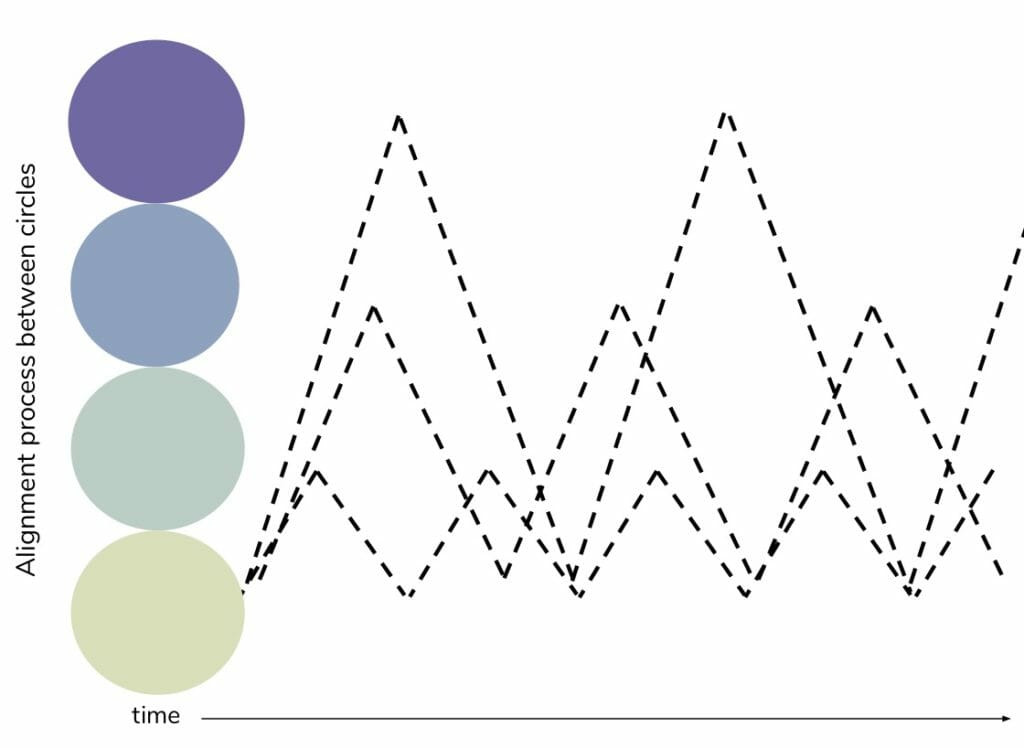Introduction
This article describes how strategy in sociocracy works out and how an organization can make sure a strategy is aligned and alive in the organization. To set the stage, let’s first talk about how a sociocratic organization is built.
Organizations as ecosystems
A decentralized, sociocratic organization is like a living entity. Living organisms consist of different systems that are semi-autonomous, like the vascular system and the respiratory system. Most of the time, I can think of my vascular system doing its thing separately from my respiratory system. When I run up a hill and my heart beats faster as I am out of breath, it becomes evident that the two systems are interdependent. No system is an island, and yet, each system defines how it works according to its own rules.
Another concept sociocracy is borrowing from natural systems is the idea of nesting. Each system is part of another system, just like ecosystems are part of the next-bigger ecosystems. A leaf is part of a tree is part of a forest that will itself be part of a larger system.
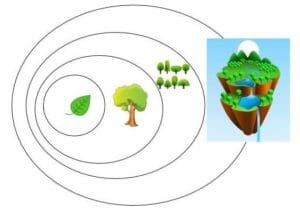
Domains in decentralized organizations are built the same way. An organization has a shared purpose, and all of its parts align with that purpose. Aims (or mandates) are more concrete and describe the meaningful “chunks” of that purpose, and we can chunk them into smaller pieces, like sub-aims or aims of sub-circles. (Read more about domains.)
“Higher” doesn’t mean “more important”
It’s key to see that the “smaller” pieces are not less valuable than the “bigger” pieces. Assuming adjectives like higher/lower or inner/outer can sometimes feel like references to worthiness. Yet, saying that being a member of a “higher” group is worth more than being part of a “lower” group would be like saying that a tree is less worthy than a forest. It’s clear that a forest is not a thing without trees, and a tree is nothing without its next-higher ecosystem.
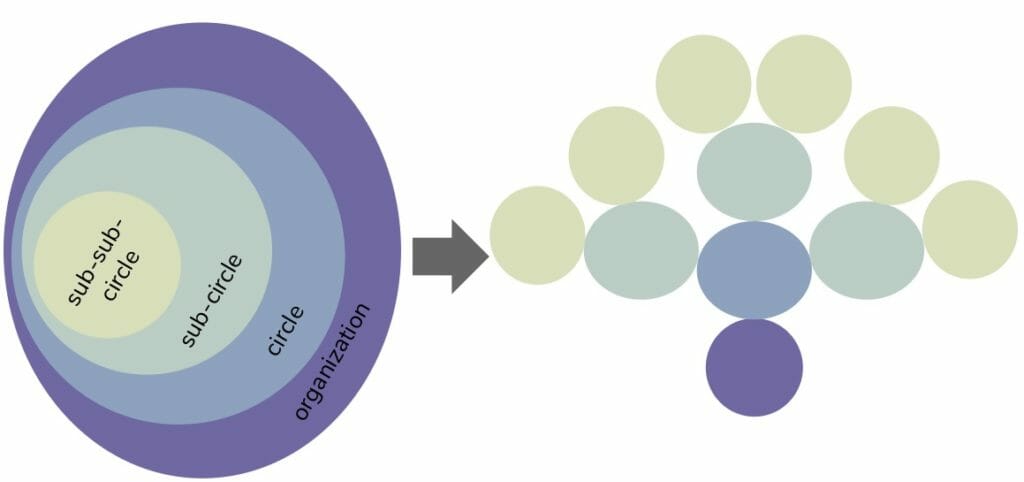
All a governance system is trying to do is to mimic these relationships to ensure the way we structure our groups aligns as organically as possible. (Read about circle structure in sociocracy.)
In a decentralized, non-coercive system, there are also not power-over relationships between the layers. A forest can’t demand from a tree to grow faster. A tree can’t tell a forest to provide more resources. It’s just not how things work. An ecosystem is an interconnected, interdependent, complex system. Each is doing their part, and in connection with others, the information and the resources that flow will impact other parts. This is true in any organization.
Changes over time
What might come easily to forests is hard to do intentionally and consciously. Information flow doesn’t just happen, we often have to make it happen.
How can we make sure all of these layers are aligned? How can we make sure everyone and everything creates synergy with the rest?
Mission
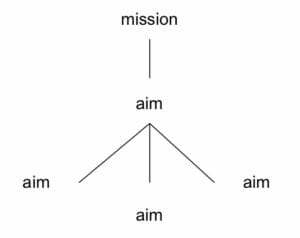 The overall mission of an organization will rarely change over time, and if so, then rather slowly. For example, if climate change is averted, climate organizations might dissolve or focus on other purposes.
The overall mission of an organization will rarely change over time, and if so, then rather slowly. For example, if climate change is averted, climate organizations might dissolve or focus on other purposes.
Aims
On the other hand, aims of individual circles might change. For instance, over time, people in the organization might notice that a certain way of achieving the mission has been missing. Or they might realize that one aim they have been working on isn’t supporting the mission effectively. Aims of sub-circles might change even more often, and aims of sub-sub-groups will change quite frequently, as teams complete projects and other projects gain importance.
Strategy
A strategy is a way to focus the energy and operations in a certain way, for a set time. That can be 6 months or a year or 5 years.
Comparing to a human being again, the aims describe the human’s functions that need to be “managed” to “run” the human. We need a respiratory system, a muscular system, and so on. The strategy tells what the human being will pay attention to. Strategy, the way I understand it, leaves behind the metaphor of an ecosystem and adds consciousness and attentiveness to the system. It’s like an overarching narrative or a theme. That narrative is overarching and needs to include all the pieces of the organization. And it is that shared narrative that aligns the consciousness of all sub-circles. That’s when things get exciting!
Strategy in sociocracy
In a typical top-down, coercive organization, the board will write up strategy, approve it, and then demand that the strategy is implemented. However, in a decentralized, non-coercive system, there is no coercive top-down process. No “higher” group can tell a “lower” group to do anything. Even less what to think while doing their work! So does that mean there’s no strategy? I think that’s well possible but not always desirable. A mission can be enough of a meaning-making narrative to tie the aims and operations together in people’s minds. But sometimes the mission might be too unachievable, or not responsive enough to the given context. In that case, a shared strategy can help bring more alignment and effectiveness by inspiring and motivating people. It adds more meaning to the pieces, and humans do really well with meaning.
Yet, in a decentralized, non-coercive organization, the only real way to have a strategy and alignment is to create a process that is at the same time top-down and bottom-up.
Strategy: top-down
In a non-coercive decentralized organization, the strategy will be defined by a group that holds strategy in its aim. Typically, that group will be situated in a “higher”, wider-scope part of the organization. (Why? A strategy probably makes no sense at the level of a leaf. It makes more sense at the level of a forest and a lot of sense at the bioregion level.)
The strategy will consider the theory of change and an assessment of the outside world, the wider ecosystem. What is happening out there, and how do we respond?
Of course, a strategy on paper doesn’t change the world. To become a reality, the strategy needs to be known in all parts of the organization so each part of the organization can do its part to carry it out. Since all teams are part of operations somewhere, each can evaluate how the strategy can inform their operations. If the strategy is known and exciting enough, people will want to carry it out.
Strategy: bottom-up
A strategy will be best if it considers the input from the more “concrete” parts of the organization. For example, direct action groups might hear people in the streets react to their action and will gauge the level of the public’s support both of their cause and the actions. Not taking into consideration that data would mean writing a strategy that has no connection with real-life experience.
Each level, each system provides information. Using the example of the human body again, someone might decide in their head that they want to be healthy and engage in exercise. They might choose to ignore the blisters on their feet for a while but if they don’t listen to their muscles and joints hurting more and more over time, it might be dangerous and counterproductive. That’s why any strategy team needs to listen to the “lower” teams and make changes accordingly. (Note, this strategy team can be a helping circle or the Mission Circle.)
Strategy: alive and aligned
Once the strategy is ready, the strategy needs to be understood and kept in people’s consciousness. Once it’s alive, it needs to stay alive. Here’s how!
Alive
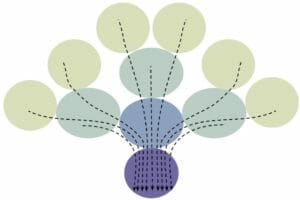 To stay alive, one key piece is to discuss it frequently. FAST goals state that “goals should be embedded in ongoing discussions to review progress, allocate resources, prioritize initiatives, and provide feedback”. We shouldn’t only look at the strategy when the year begins and when we write the next strategy paper. It should be more often – but how often can be defined by each circle. Ideally, as the new strategy is rolled out, each team reflects on it in their own meeting to see how their aim interplays with the strategy. The team can then add their puzzle piece to the whole.
To stay alive, one key piece is to discuss it frequently. FAST goals state that “goals should be embedded in ongoing discussions to review progress, allocate resources, prioritize initiatives, and provide feedback”. We shouldn’t only look at the strategy when the year begins and when we write the next strategy paper. It should be more often – but how often can be defined by each circle. Ideally, as the new strategy is rolled out, each team reflects on it in their own meeting to see how their aim interplays with the strategy. The team can then add their puzzle piece to the whole.
Ideas on how to make this happen (mix and match!)
- Read the strategy (or your summary thereof) at the beginning of every meeting. (Caution: it might get old soon! Mix it up!)
- Have a 30min discussion every 4rd meeting to see what new ideas are coming up. You can even slice it into smaller bits and address them all separately over time.
- Translate the strategy into smaller objectives (like OKRs) and track them. Revisit the OKRs and their relationship to strategy, so you don’t forget the overarching strategy while focusing on indicators or numbers.
- Create a role of someone who holds the strategy in their consciousness and speaks from that role in each decision. It could also be attached to the leader role. The holder of the role could speak as a team member and a strategy advocate separately so it’s heard as an overarching point.
- Invite a strategy team member to a meeting from time to time to rejuvenate the discussion.
Aligned
Of course, nothing stays constant—everything changes over time, including strategies. A strategy has to be a living document that can be adapted. Back to our example of a human engaging in an exercise routine, that person might have sore muscles the first 2 weeks but then the body might get used to the workout. Then we’ll need a new routine!
At the same time, maybe some pieces of the strategy are mistaken. For example, it might be overall healthier to alternate running and swimming, and joint pain might be an indicator that could inspire to make that change. Therefore, just like an exercise routine should not remain the same for a whole year, we have to expect changes to the strategy.
We all do this all the time on an individual level – the trick is to do it on an organizational level! The changes over time again have to happen top-down and bottom-up. The “specific” teams need to have a way to give feedback, and if the strategy gets adjusted, then all teams need to be informed about that.
For alignment to happen, each team needs to communicate its plans on implementing the strategy. Proactive transparency will improve alignment and overall synergy.
Ideas on how to make this happen (mix and match!)
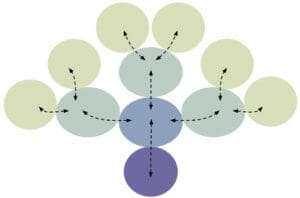 The strategy team defines its preferred way of receiving input on the strategy. Each team can then submit amendments to the strategy as new information or new ideas emerge. If a significant change is made, the strategy team reports that change to all circles with appropriate background info or rationale.
The strategy team defines its preferred way of receiving input on the strategy. Each team can then submit amendments to the strategy as new information or new ideas emerge. If a significant change is made, the strategy team reports that change to all circles with appropriate background info or rationale. - Communicate! Circles can tell the circles around them what sense they are making of their puzzle piece of the strategy. Or they can share the objectives or indicators they’re paying attention to. Post all objectives or indicators organization-wide.
- Have explorations and sharings across circles on individual topics of the strategy (for example, an alignment meeting of all delegates).
- Invite strategy team members to circle meetings from time to time. That gives a chance to give feedback so the strategy team can carry that information into other places of the organization.
The timeline for each of those concrete manifestations of strategy adjustments and alignments needs to work in the concrete organization. In a volunteer-run organization, it might be different from a workplace. An activist group will do it differently from a school.
The only important thing, as usual, is to find a way intentionally that works for everyone.
